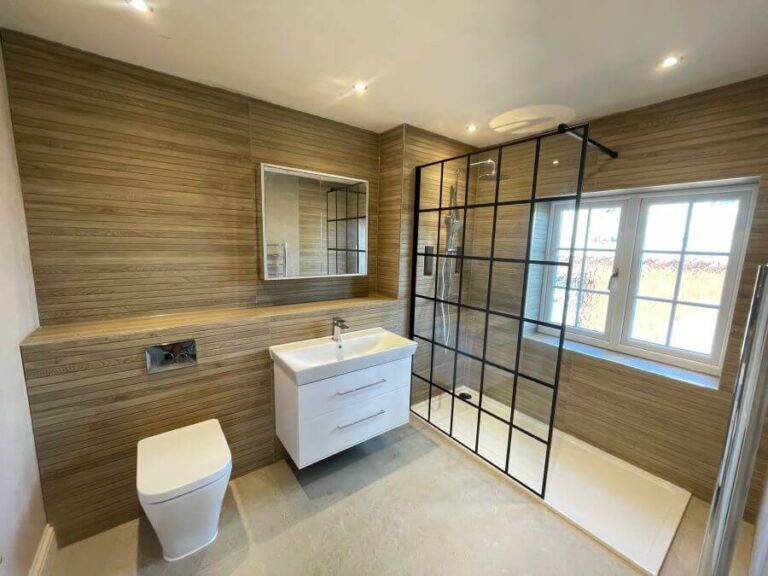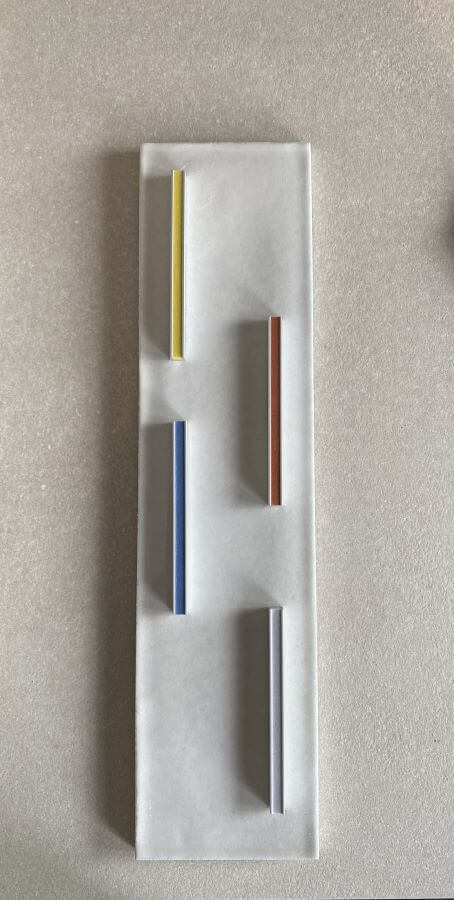Choosing a porcelain grout or ceramic tile grout colour
October 19, 2023
Jo Gilhooly
Choosing a porcelain grout or ceramic tile grout colour

Whilst your tiles are always the star of the show, porcelain grout plays an important role. As well as enhancing the overall look of your tiled floor or wall, it also holds tiles in place and ensures there are no dirt traps so debris can’t build up between tiles. Choosing the right ceramic tile grout colour is ultimately a personal choice. In some cases you may want your porcelain grout to blend as seamlessly as possible with your chosen tiles to create a harmonious overall effect. Or you may want your grout colour to act as a feature highlighting individual tiles for a fresh, funky feel.
With rectified tiles allowing for minimal grout joints eg 3mm for floors and 2mm for walls (for very large format tiles you will need to possibly allow a slightly wider grout joint) the amount of grout on show is minimal, however, it is still important to pick carefully and wisely so let’s explore how to select a ceramic tile grout colour and create a beautiful tiled surface.
Tile Size & layout
With the latest manufacturing techniques, tiles are getting larger. Sizes and formats that previously may have been the go to for commercial interiors are now making their way into our homes. A 1200 x 1200mm tile is equally at home in a residential kitchen or dining space as it is in a stunning hotel lobby.
Larger tiles make for less grout lines and picking a grout colour that closely matches the tile colour can create a more seamless appearance making a space feel more expansive.
Even wall tiles are in larger than ever before formats, like our Season 1m x 33cm wood effect wall tiles. These tiles have been designed specifically to deliver a seamless effect so the obvious choice would be a grout that matches as closely as possible making it harder to distinguish where tiles begin and end. Here’s a great example from a real project where the client has matched the grout as closely as possible.


Larger format tiles are often designed to bring a seamless feel to spaces.
Smaller tiles, by contrast, will have more grout lines. That in turn can make a space feel busy so if your aim is to showcase your tiles but keep a relatively seamless look and feel it is worth considering opting for a closely matching grout.
Unless of course you specifially want to make a feature of your tiles ie in some cases with smaller tiles you may want to emphasise the tile pattern of course especially for intricate patterns like herringbone or chevrons.
Some tile manufacturers do advise a grout colour option so for example with our Mini Metallic Blu the grout colour option shown here is Mapei 119. It works beautifully with the overall colour theme.

Tile colour
Some tiles are a flat colour so pretty easy to match to (or contrast with) so think a matt white tile. However, most tiles have some kind of colour variation across the surface, think stone effect, limestone effect, woods, concretes or metallics. In this case picking a colour in the tile to match grout to is a good idea if you want to co-ordinate colour.
For example, if we take a Griege colour tile that could vary from a light grey to a taupe. Picking the dominant tile colour will bring a more seamless effect or if you pick a colour in the tile as a contrast. A neutral grey or beige will usually work. So unless you are looking for maximum contrast here are a few tips by tile style:
Marbles: For marbles with a dominant colour it’s worth trying to match as closely as you can to the background colour.
Patterned tiles: The recommended grout colour for these pretty patterned tiles is Mapei 111 which is a neutral white. You could have course have plenty of fun picking a grey, pink or sand grout here too! It all depends what you want to achieve!
Stone and Limestones: Picking either the dominant overall tile colour for a more seamless effect or pick a colour in the tile itself – soft and neutral greys and beiges usually work well.
Woods: A good quality wood effect porcelain tile or ceramic tile will vary in design – and from plank to plank. For example some of our woods have up to 39 different patterns to make them as realistic a possible, so picking either the dominant colour or a colour in the tile itself is a good option.
Concretes and Cements Even these can have variation in colour so for a seamless feel picking the dominant tile colour is a good idea.
Terrazzo – can be trickier! There can be lots of colours. Some terrazzo tiles have a dominant background colour or, again, look for the dominant colour or to match to a colour in the tile.

For patterned tiles try co-ordinating with the background colour or have fun and pick out colours in the tiles themselves!
Practicalities
As well as aesthetics, it is important to consider the practical side of grout colour too. From a maintenance perspective light colour grout may darken a little over time. However, there are some excellent grout protector products available that will help keep your grout looking pristine for longer.
Epoxy grout is more stain resistant and durable compared to a traditional cementious or cement based grout, however, epoxy can be trickier to work with.

Using a colourful contrasting grout with a simple white tile can bring a fresh, fun feel.
Whatever grout type and colour you select, ensuring you are employing the services of a professional installer is a must as is asking their opinion and advice. It can be worth ordering a couple of extra tiles so you can play around with grout colours.
Most grout manufacturers have colour charts so you can pop grout colours in between tiles to see for yourself. Even once you have selected a colour grout it may be worth just trying it on a smaller area or a couple of spare tiles just to be sure.

A grout colour guide can help with decisions
In summary
Grout colour is a personal choice and there are no rules! However a few considerations can help with the decision:
1. Think about what you want to achieve – a seamless overall feel to enhance a feeling of space or to accentuate your tiles.
2. For a more seamless feel if a tile has a dominant overall colour eg a white background with marble veining then co-ordinate as closely to the background colour as you can. For tiles with a varied pattern eg a stone effect tile – look for the main colour in the tile. OR, if you prefer to go a shade or two darker, then look for those tones in the tile and try to match to those.
3. If you want to contrast then this really is personal choice – contrasting grout can make spaces look busier especially for smaller tiles but it can also bring a fresh and funky design to spaces – think white tiles and orange grout!
4. Get expert advice if you are unsure, check with your tiler, use a grout guide book to play with different grout colour options and perhaps use a couple of spare tiles to test out a porcelain grout or ceramic tile grout colour before committing to the entire area.
The TilePortfolio specialise in Italian and Spanish Porcelain and Ceramic tiles, in particular large format Porcelains and Porcelain tiles for inside and outside. Our carefully curated, stunning tile portfolios are beautifully presented online and supported by our fuss-free ‘go-the-extra-tile’ service. In addition, you can view our entire tile collection at our Northamptonshire Showroom. Visit our website for unmissable interiors inspiration. The TilePortfolio team are always available to chat, we’d be delighted to help with your project so please do get in touch. https://www.thetileportfolio.co.uk/
Please note: We strongly recommend
using a professional tiler for your project. Installation requirements may vary
depending on the tiles you choose, the fixing products used and the specific
conditions. Always check with your tiler regards the suitability of the tiles.
Please get in touch with us if you have any questions.

